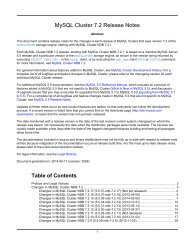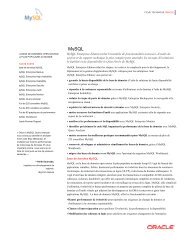MySQL 5.7 Release Notes - Download - MySQL
MySQL 5.7 Release Notes - Download - MySQL
MySQL 5.7 Release Notes - Download - MySQL
Create successful ePaper yourself
Turn your PDF publications into a flip-book with our unique Google optimized e-Paper software.
<strong>MySQL</strong> <strong>5.7</strong> <strong>Release</strong> <strong>Notes</strong>• The setup_timers table contains a new row with a NAME value of transaction that indicatesthe unit for transaction event timing. The default unit is NANOSECOND.For more information, see Performance Schema Transaction Tables, and Transaction SummaryTables.If you upgrade to this release of <strong>MySQL</strong> from an earlier version, you must run mysql_upgrade (andrestart the server) to incorporate these changes into the performance_schema database.Security <strong>Notes</strong>• Incompatible Change: Previously, the --ssl option has been treated as advisory: When given, anSSL connection was permitted but not required. Also, several other --ssl-xxx options implied --ssl. Because of this, the option was usually not used explicitly as --ssl, but in its negated form as--ssl=0, which prevents use of SSL. This was true on both the client and server sides, and truefor any synonyms of --ssl (--ssl=1, --enable-ssl) or --ssl=0 (--skip-ssl, --disablessl).Now the meaning of --ssl has changed on the client-side only. (There are no SSL changes on theserver side.)When given on the client side as --ssl (or a synonym), the option now is prescriptive, not advisory:The client connection must use SSL or the connection attempt fails. In addition, other SSL optionsno longer imply --ssl. This is an incompatible change in the sense that <strong>MySQL</strong> client commandsthat use --ssl now will fail unless an SSL connection can be established. On the other hand, for asuccessful connection attempt, the connection is guaranteed to use SSL. Previously, there was nosuch guarantee.If other --ssl-xxx options are given in the absence of --ssl, the client attempts to connect usingSSL. If the server is not configured to permit SSL, the client falls back to an unencrypted connection.There is no change in the meaning of --ssl=0 (and its synonyms) to prevent use of SSL andoverride other SSL options.A new MYSQL_OPT_SSL_ENFORCE option is available for the mysql_options() C API functionto indicate whether to require the connection to use SSL. If enabled, it has the same effect asspecifying --ssl on the command line: If an encrypted connection cannot be established, theconnection attempt fails.For more information, see SSL Command Options, and mysql_options().The MASTER_SSL=1 option for the CHANGE MASTER TO statement has changed as well, analogousto the change in the meaning of --ssl. That is, when given, the slave connection to the master mustuse SSL or the connection attempt fails.Functionality Added or Changed• Performance; InnoDB: The log_write_up_to function, which writes to redo log files up toa certain log sequence number (LSN) and optionally flushes writes to disk, has been refactoredto improve performance for workloads with heavy log_sys::mutex contention and whereinnodb_flush_log_at_trx_commit=2.• Performance: The LOCK_thread_count mutex protected several independent internal serverstructures and variables, and was a bottleneck, particularly affecting server performance in thecircumstance when many clients were connecting and disconnecting at once. This mutex wasdecomposed into more specific mutexes and atomic operations to alleviate the bottleneck andimprove performance.As part of this work, the following status variables are no longer visible in the embeddedserver because for that server they were not updated and were not meaningful:41
















